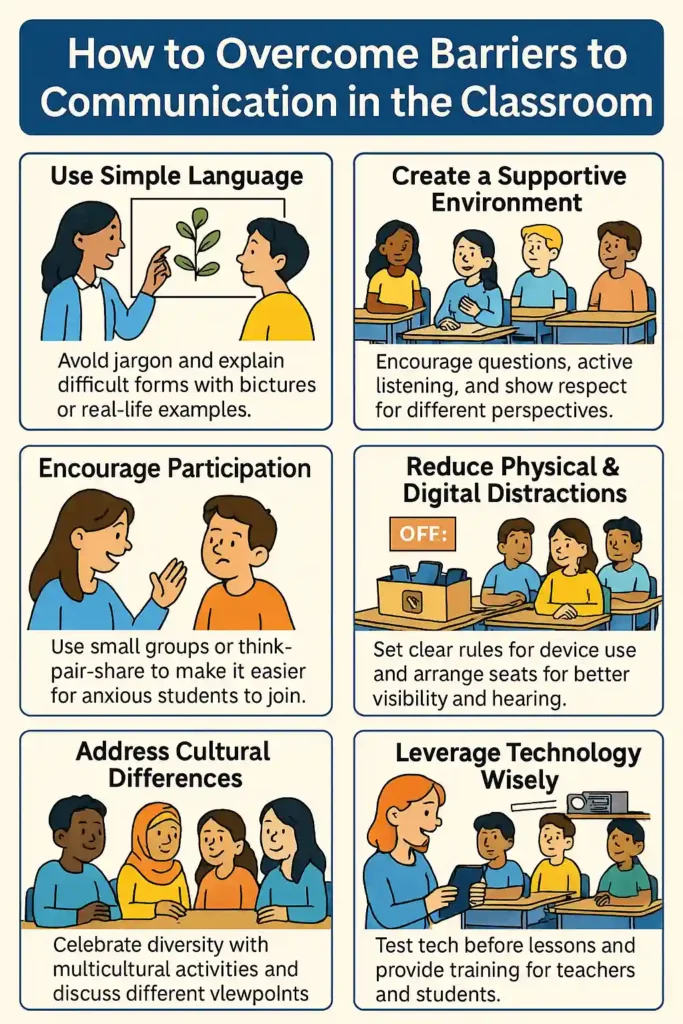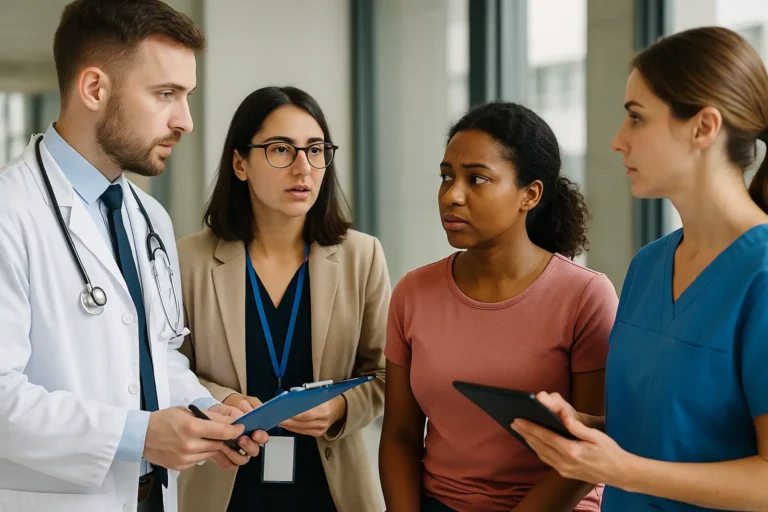Barriers to Classroom Communication
Effective communication in the classroom is the foundation of a thriving learning environment. Yet, even with dedicated teachers and enthusiastic students, real obstacles can get in the way. Why do some lessons flow smoothly while others are full of confusion and missed messages? The answer often lies in the barriers to classroom communication that quietly disrupt teaching and learning. From language differences and nonverbal misunderstandings to learning disabilities, technology gaps, and even classroom setup, these challenges can have a big impact. Understanding and addressing these barriers helps teachers create classrooms where every student can succeed.
Understanding Barriers to Classroom Communication
Classroom communication involves much more than speaking and listening. It’s a blend of words, tone, gestures, written instructions, feedback, and classroom dynamics. Yet, barriers to classroom communication can arise at any point, leaving teachers and students feeling frustrated or disconnected. These obstacles range from language difficulties to cultural misunderstandings, and even extend to generational and socioeconomic differences.
Creating a truly inclusive classroom means being able to recognize, understand, and reduce these barriers. Let’s take a closer look at what causes communication breakdowns in education, how they affect learning, and the strategies that make a difference.
Types of Barriers to Classroom Communication

Language Barriers
Language barriers are among the most visible obstacles to clear classroom communication. In many schools, classrooms are full of students who speak different first languages or have varying degrees of language proficiency. These differences can lead to:
- Difficulty understanding instructions
- Misinterpretation of vocabulary or grammar
- Limited participation in discussions
- Struggles with reading comprehension
Vocabulary challenges often arise when students encounter unfamiliar academic terms. For example, a science lesson full of technical jargon can leave some students confused, especially if they are English Language Learners (ELLs). Teachers can help by using plain language, providing synonyms, and encouraging peer support for those who need extra help.
Cultural Differences and Nonverbal Communication
Culture influences how we communicate, both verbally and nonverbally. Cultural barriers can lead to misunderstandings in expectations, classroom participation, and behavior. In some cultures, direct eye contact may signal respect, while in others it could be seen as disrespectful. Gestures, tone, and personal space also vary across cultures.
Teachers must be aware of nonverbal communication signals such as facial expressions, posture, and gestures, which may be interpreted differently by students from diverse backgrounds. Including cultural competence and anti-bias education in teacher training helps build more inclusive, understanding classrooms.
Learning Disabilities and Neurodiversity
Not all communication barriers are immediately visible. Students with learning disabilities, such as dyslexia, ADHD, or speech-language impairments, may struggle to process verbal or written instructions. Neurodiversity refers to the natural variation in how students think, learn, and interact. Recognizing and supporting these differences with tools like Individualized Education Plans (IEPs), Universal Design for Learning (UDL), and classroom accommodations ensures all students have a voice.
Psychological and Emotional Barriers
A student’s emotional state can either support or hinder communication. Lack of confidence, anxiety, stress, or negative past experiences may keep students from asking questions or sharing ideas. Emotional intelligence—skills like self-awareness, empathy, and self-regulation—helps both teachers and students manage emotions and build positive relationships in the classroom.
Strategies like restorative practices and classroom circles foster trust and encourage open communication, reducing emotional and psychological barriers.
Physical and Environmental Barriers
The physical setup of the classroom affects how well students can see, hear, and interact. Barriers include:
- Poor seating arrangements (students seated too far from the teacher)
- Inadequate lighting or distracting decor
- High levels of noise or poor acoustics
- Inaccessible facilities for students with physical disabilities
Addressing these issues may be as simple as rearranging seats, providing assistive devices, or using microphones and sound-absorbing materials.
Socioeconomic Barriers
A student’s socioeconomic background can shape their communication skills and classroom participation. Limited access to technology, books, or a quiet study environment at home can hinder learning. Food insecurity or family stress can also impact focus and engagement.
Schools that offer resource support—like meal programs, counseling, and technology lending—help reduce these barriers and create a level playing field for all students.
Technological Barriers and the Digital Divide
With the rise of digital learning, technology has become both a bridge and a barrier in the classroom. Challenges include:
- Lack of reliable internet or devices
- Limited digital literacy among students or teachers
- Cyberbullying or distractions from personal devices
- Outdated or malfunctioning classroom tech
Bridging the digital divide requires investment in infrastructure, teacher training, and programs to increase access for all students.
Generational Barriers and the Technology Gap
Today’s classrooms often bring together students from “Generation Z” and teachers from earlier generations. These groups may have different comfort levels and expectations about technology, communication styles, and classroom behavior.
Teachers who model lifelong learning and stay current with technology can help bridge this gap, while also encouraging intergenerational understanding and respect.
Teacher Communication Styles and Classroom Management
The way a teacher communicates—whether assertive, passive, or democratic—shapes classroom culture. Overly authoritative or unclear communication can silence students. Teachers who use active listening, provide regular feedback, and set clear expectations create a supportive environment where students feel safe to participate.
Classroom management also matters. Clear routines, rules, and positive reinforcement help minimize disruptions and ensure every voice is heard.
Feedback Loops and Active Listening
Communication in the classroom is not just top-down. Active listening and feedback loops—where teachers check for understanding and encourage student questions—help clarify confusion early. This two-way process builds trust and shows students that their opinions and questions matter.
Formative assessment, exit tickets, and peer reviews are just a few ways to strengthen these loops.
Real-World Examples
- A multilingual classroom where group projects succeed because peers help translate instructions and teachers use visuals.
- A student with dyslexia who thrives thanks to audiobooks, speech-to-text tools, and extra time on tests.
- A teacher who changes seating arrangements to help a shy student feel more included.
- Schools that invest in high-speed internet, loaner laptops, and digital skills workshops for students and staff.
- Implementing a schoolwide social-emotional learning (SEL) program to support emotional intelligence and conflict resolution.
Strategies to Overcome Barriers to Classroom Communication

- Embrace inclusive education: Use UDL, IEPs, and differentiation to meet every learner’s needs.
- Build cultural competence: Attend workshops, integrate diverse materials, and invite family and community input.
- Model and teach active listening: Use eye contact, open body language, and clarify meaning regularly.
- Establish feedback loops: Use formative assessments, check-ins, and peer reviews.
- Invest in digital equity: Ensure every student and teacher has reliable access to technology and training.
- Foster emotional intelligence: Teach empathy, self-awareness, and conflict resolution as part of the curriculum.
- Promote family engagement: Communicate regularly with parents and caregivers, using language they understand.
- Adjust the physical environment: Rearrange seating, reduce noise, and ensure accessibility.
- Provide professional development: Offer teachers regular training in communication, classroom management, and inclusion.
Conclusion
Overcoming barriers to classroom communication takes more than good intentions—it requires a proactive, thoughtful approach. By recognizing language, cultural, psychological, technological, and environmental obstacles, teachers and schools can create classrooms where every student has the chance to thrive. From active listening and feedback to inclusive education and digital equity, these solutions make a real difference.
If you’re an educator or school leader looking to strengthen your classroom’s communication, start by assessing your environment and listening to your students. Every small step brings us closer to an inclusive, supportive classroom where barriers fade and learning flourishes.




